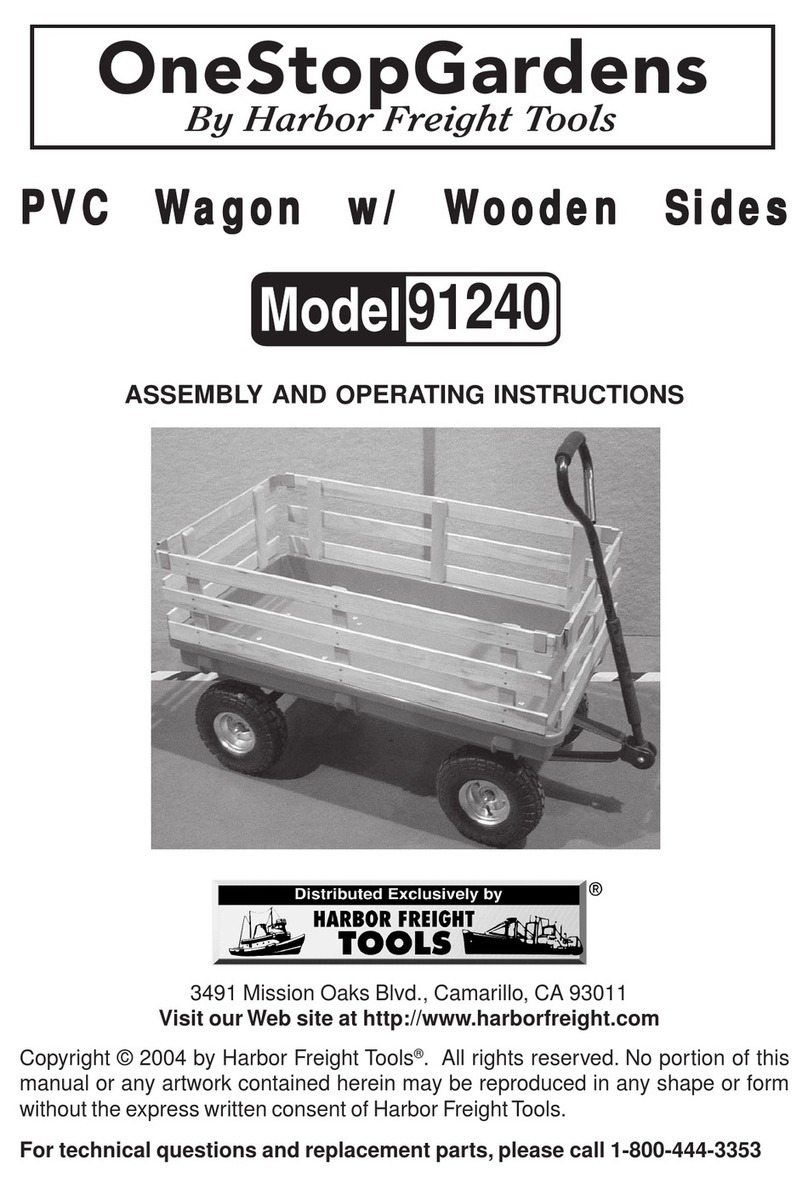
Page 4 ;&(%$*4.8"4,7%<'*#$"&8#=%/7*,#*%4,77%>?@@@?@AA?BCDC1 Item 58703
EF;6GH IJ6KFGLIM NFLMG6MFMO6FEE6NPQH
I/*(,$"&8%E,2*$U
M&$*- Selected recommendations in this section are adapted from TOWING A TRAILER -
Being Equipped for Safety, published by NHTSA. For full details, see that document.
1. This Trailer is not a toy.
Do not allow children to play on or near this item.
2. Take time to practice before driving on main roads.
3. Never allow anyone to ride in or on the trailer.
4. Do not transport animals in this trailer.
P*2&(*%6,4.%W#*
1. Check Tire condition and air pressure.
2. Make sure wheel lug nuts/bolts
are properly tightened.
3. Make sure hitch, coupler, draw bar, and other
equipment that connect the trailer and the tow
vehicle are properly secured and adjusted.
4. Make sure wiring is properly connected — not
touching the road, but loose enough to make turns
without disconnecting or damaging the wires.
5. Make sure all running lights, brake lights,
turn signals, and hazard lights are working.
6. Check that all items are securely
fastened on and in the trailer.
7. Be sure the trailer jack, tongue support, and any
attached stabilizers are raised and locked in place.
8. Check load distribution to make sure
the tow vehicle and trailer are properly
balanced front to back and side to side.
9. Check side- and rear-view mirrors to
make sure you have good visibility.
10. Check routes and restrictions
on bridges and tunnels.
11. Make sure you have wheel chocks and jack stands.
12. Check trailer for loose bolts and nuts,
structural cracks and bends, and any
other condition that may affect its
safe operation. Do not use the Trailer
even if minor damage appears.
S*8*(,7%X,897"83
1. Use the driving gear that the towing vehicle
manufacturer recommends for towing.
2. Drive at moderate speeds. This will place
less strain on your tow vehicle and trailer.
Trailer instability (sway) is more likely to
occur as speed increases. T&%8&$%*Y4**9%
ZB%5"7*#%/*(%.&'(%).*8%$&)"83%$.*%G(,"7*(1
3. Avoid sudden stops and starts that can
cause skidding, sliding, or jackknifing.
4. Avoid sudden steering maneuvers that might
create sway or undue side force on the trailer.
5. Slow down when traveling over bumpy roads,
railroad crossings, and ditches.
6. Make wider turns at curves and corners.
Because your trailer’s wheels are closer to the
inside of a turn than the wheels of your tow vehicle,
they are more likely to hit or ride up over curbs.
7. To control swaying caused by air pressure changes
and wind buffeting when larger vehicles pass from
either direction, release the accelerator pedal to slow
down and keep a firm grip on the steering wheel.
P(,["83
1. Allow considerably more distance for stopping.
2. If you have an electric trailer brake controller and
excessive sway occurs, activate the trailer brake
controller by hand. Do not attempt to control
trailer sway by applying the tow vehicle brakes;
this will generally make the sway worse.
3. Always anticipate the need to slow down.
To reduce speed, shift to a lower gear
and press the brakes lightly.
F44*7*(,$"&8%,89%J,##"83
1. When passing a slower vehicle or changing lanes,
signal well in advance and make sure you
allow extra distance to clear the vehicle
before you pull back into the lane.
2. Pass on level terrain with plenty of clearance.
Avoid passing on steep upgrades or downgrades.
3. If necessary, downshift for improved
acceleration or speed maintenance.
4. When passing on narrow roads, be careful not
to go onto a soft shoulder. This could cause
your trailer to jackknife or go out of control.






























